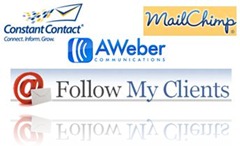Where I Think You Want To Be With Your Approach to Social Media:
For the last six months, I’ve spent a fair amount of time studying social media and learning how to use it both personally and in business. I joined Facebook (after telling my family and friends that I’d never do so), launched a Fan Page, RE Marketing Exchange, and of course the blog you’re now in. I still have a way to go with my own implementation, but, today, I want to start out by sharing with you what I believe you’ll want to work toward in implementing your social media business strategy.

To begin, I think that you have to understand what
social media is and what it is not. Thinking about it’s use in business: for me, I believe that it is a powerful tool for staying connected and “top of mind” with your clients, as well as a great way to meet and acquire new clients. Social media is NOT a substitution for direct contact with your clients and potential clients, nor does it enable one to provide, less than superior products and service.
First, I think that you’ve got to be on Facebook, as it’s likely where the majority of your customers are already hanging out. If you’re not, you’re missing out on a great way to stay connected not only to your clients, but friends, family members, former colleagues, and heck, even your competition … and it’s a great place for people to get to know you.

Second you must have a blog, for it’s your blog from which you’ll provide your customers with engaging content that they find of value, and which they’ll want to return to. Third, you’ll want to understand how to create a call to action, whether it’s a free report, webinar, receiving automated email updates, new listings,or even a contest. And key to your call to action is that you MUST capture leads! After all, unless you’re running a philanthropy, why would you want to expend the time and effort, unless you had a way to understand who is reading your content? “You’ll never be able to figure out how to help them, unless you know who they are and how to contact them!” You must engage them. If you don’t, someone else will!
Next, you’ve got to have a database in which you store relevant information about your clients, potential clients, and business partners. It doesn’t have to be complex … heck, a simple Excel spreadsheet will do the trick until you can justify something more robust.
…And for now, I’ll end with this one … You’ve got to have an email marketing program or service. Yes you can try to stay top of mind using only Facebook, Twitter, or your blog, but think about it for a moment. Think about your own Facebook News Feed. Right now, I only have 121 Friends on my Facebook profile. It’s rare that I’m able to get through them all … I don’t have the time.

Gail Goodman with Constant Contact said it best when in an interview for Duct Tape Marketing she said:
“Twitter is good for reaching a lot of new audience, but at 140 characters, engagement is light. FB has nice reach and more engagement than Twitter, but nowhere near the engagement as that standalone moment in someone’s mailbox; where instead of being on a “News Feed” or short form Fan Page, you really get to create an html content email to tell your story in the way you want to tell it …. And in that briefest of standalone moments when someone is looking JUST at your email. The shortcoming with social media sites is that people are often distracted.”

You know …. how often have you caught yourself going … “How did I ever end up here?” It’s all those Bright Shiny Objects!
So how do you get started? It’s actually pretty easy. Just don’t attempt to do it all at once. If you have even the slightest amount of tech skills or know someone that does, you can pull this off yourself or with their help. Hey … and I’m here to help any way that I can. And if you’re not inclined to take the home grown route, let me know. I’ve met a couple of people that can help. They’re good at what they do and very reasonable.
An added bonus:
Thinking about how to perhaps include a brief presentation on how this all fits together, here’s a Prezi presentation that Liz Landry from Keller Williams put together. It’s well done. BTW, for best viewing, click on the “More” at the bottom right, then Fullscreen, and then Autoplay.
Personal Update:
As some of you may or may not know, I recently joined North Easton Savings Bank (NESB) headquartered in South Easton, MA, after a lengthy process of searching for the right institution to work with. For the Bank, my title is Mortgage Specialist, and my focus is residential, construction, commercial, and deposit business development for the Bank on Cape Cod and the adjacent coastal communities. For my clients, customers, and the communities I’ll be serving, what I’m all about is:
- Helping my real estate professional clients build their real estate business;
- helping customers obtain a home loan they can afford and insuring that customers understand the benefits of viewing their mortgage as a financial tool, that when managed properly can improve their financial health; and
- giving back to the communities where I live and work
You can learn more about me by clicking on my profile, in the side bar.
Technology is providing us all with alternative opportunities to meet and share. If you get a chance, come and share with us on Facebook, too, @
RE Marketing Exchange … and if you haven’t already done so, subscribe via the Feed by clicking on Post, at the bottom of this page; or you can subscribe via email by clicking:
Subscribe to RE Marketing Exchange by Email.
 Very well done video by RSA, http://www.thersa.org/ And who is the RSA? From their site: “In the light of new challenges and opportunities for the human race our purpose now is to develop and promote new ways of thinking about human fulfillment and social progress.” … and they’ve been at it for more than 250 years.
Very well done video by RSA, http://www.thersa.org/ And who is the RSA? From their site: “In the light of new challenges and opportunities for the human race our purpose now is to develop and promote new ways of thinking about human fulfillment and social progress.” … and they’ve been at it for more than 250 years. 
![us-airways[1] us-airways[1]](http://lh5.ggpht.com/_p_G-qN4DbzY/TLZorKdasyI/AAAAAAAAAFQ/e4yvG0tWDaA/us-airways%5B1%5D_thumb%5B1%5D.jpg?imgmax=800)






